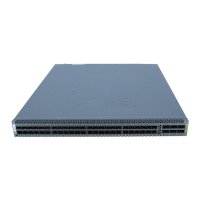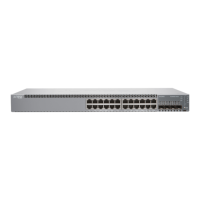Dispersion is the spreading of the signal over time. The following two types of dispersion
can affect signal transmission through an optical data link:
•
Chromatic dispersion, which is the spreading of the signal over time caused by the
different speeds of light rays.
•
Modal dispersion, which is the spreading of the signal over time caused by the different
propagation modes in the fiber.
For multimode transmission, modal dispersion, rather than chromatic dispersion or
attenuation, usually limits the maximum bit rate and link length. For single-mode
transmission, modal dispersion is not a factor. However, at higher bit rates and over longer
distances, chromatic dispersion limits the maximum link length.
An efficient optical data link must have enough light to exceed the minimum power that
the receiver requires to operate within its specifications. In addition, the total dispersion
must be within the limits specified for the type of link in the Telcordia Technologies
document GR-253-CORE (Section 4.3) and International Telecommunications Union
(ITU) document G.957.
When chromatic dispersion is at the maximum allowed, its effect can be considered as
a power penalty in the power budget. The optical power budget must allow for the sum
of component attenuation, power penalties (including those from dispersion), and a
safety margin for unexpected losses.
Calculating Power Budget and Power Margin for Fiber-Optic Cables
Use the information in this topic and the specifications for your optical interface to
calculate the power budget and power margin for fiber-optic cables.
TIP: You can use the Hardware Compatibility Tool to find information about
the pluggable transceivers supported on your Juniper Networks device.
To calculate the power budget and power margin, perform the following tasks:
1.
Calculating Power Budget for Fiber-Optic Cable on page 73
2.
Calculating Power Margin for Fiber-Optic Cable on page 74
Calculating Power Budget for Fiber-Optic Cable
To ensure that fiber-optic connections have sufficient power for correct operation, you
need to calculate the link's power budget, which is the maximum amount of power it
can transmit. When you calculate the power budget, you use a worst-case analysis to
provide a margin of error, even though all the parts of an actual system do not operate
at the worst-case levels. To calculate the worst-case estimate of power budget (P
B
),
you assume minimum transmitter power (P
T
) and minimum receiver sensitivity (P
R
):
P
B
= P
T
– P
R
The following hypothetical power budget equation uses values measured in decibels
(dB) and decibels referred to one milliwatt (dBm):
73Copyright © 2019, Juniper Networks, Inc.
Chapter 2: Site Planning, Preparation, and Specifications
